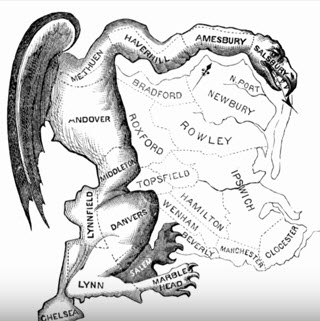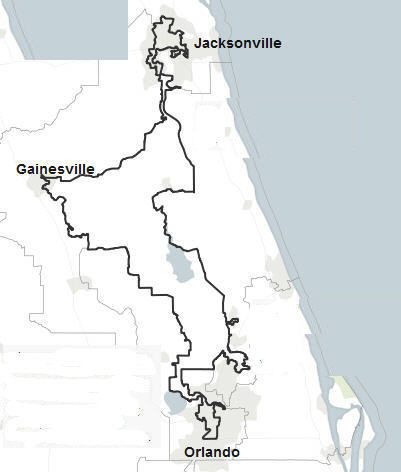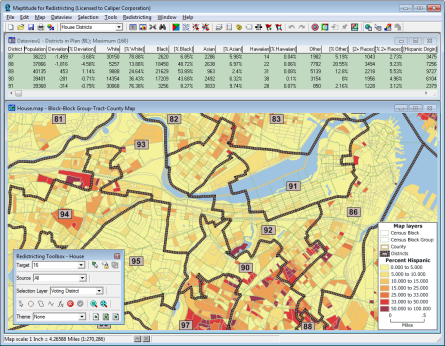Redrawing the Map to Rig Elections
Apr 9 2012In "Have They Stolen Your Vote", this page reported on new laws around the country, such as the requirement for photo IDs, that are meant to impede citizens from registering to vote. Operating in parallel are legislatures that have been grappling to redraw their states' electoral maps to engineer districts that will vote their way, whether Democrat or Republican.

The 1812 cartoon in the Boston
Gazette mocking the shape of one of
Gov. Gerry's contrivances.
Once every ten years, based on the population census, each state usually must reconfigure its voting districts, first to conform to the number of congressional representatives that its newly-counted population permits, and then to arrive at approximately equal numbers of voters in each district. That upheaval gives either party the opportunity to redraw districts in their favor.
The goal is either to draw a boundary around neighborhoods that vote for your own party to guarantee that your candidates — state and federal — will be elected — or to cordon off the maximum number of voters from opposing groups into as few districts as possible to minimize the number of legislators from their party.
There’s nothing new about this practice. Called gerrymandering, the word derives from 1812’s governor of Massachusetts, Elbridge Gerry, who rearranged election districts to his liking. The contorted shape of one of them reminded people of a salamander.
Such maneuvering has lasting consequences: the districts do not change until after the next census in 2020 and the presidential election of 2024. The last 10 years show the effect: only 22% of the seats in the House of Representatives changed hands during the entire decade. In California, a single seat out of 53 switched party control during those years. That led to a proposition that millions spent by unions and other Democratic groups could not keep off the ballot, disrupting as it would be to districts that had long ago been tailored in their favor. The proposition passed, a measure to bring redistricting out in the open by assigning responsibility to a nonpartisan commission, and California joined six other states (Arizona, California, Hawaii, Idaho, Minnesota, New Jersey and Washington) with similar commissions.
The 2010 election swept Republican majorities into the state legislatures that control the redistricting process in 36 states, and much of the remapping is thus producing districts that contain a preponderance of Republican voters. Often as not, the method is to pack minority groups such as Latins and blacks — traditionally Democratic voters — into as few districts as possible. The aim is to limit them to a minimum of representatives in Congress while "bleaching" the surrounding districts to make them safe for Republican candidates.
In North Carolina, Republicans captured control of the legislature in 2010 for the first time since just after the Civil War and drew district lines so as to corral 49% of all the state’s African-American voters into just three of the state’s 13 electoral districts, leaving the remaining districts mostly white.
Democrats play the same game in reverse. In Nevada, where population growth has added a seat, Republicans are trying to block an attempt by Democrats to spread the new Latino voters into as many as possible districts in the hope they will tilt their vote Democratic.
Redistricting battles often lead to court fights. Charged with redrawing the maps to add four new districts, the Republican majority in the Texas legislature brought forth a map that disadvantaged the very same Latino and black voters who had accounted for 89% of the state's population growth that won the four new congressional seats. In response to suits 
Gerrymandered district in Florida, where areas are strung
together by a connection no wider than a road to 'capture' the
African-American population and "bleach" the surrounding area.
brought by Democrats and minority groups, a federal district court in San Antonio drew its own map, but the U.S. Supreme Court stepped in to give control back to the legislature.
The contorted shapes that gerrymandering produces are grotesque reminders that our democracy needs an asterisk. This CNN report offers an example of how elections are rigged by taking us to an uninhabited grass strip in Chicago that separates two highways and is the only thing connecting two residential areas strung together to satisfy the requirement that a district be contiguous.
Redistricting is complex, and as one might expect, software companies have obligingly created the tools for apportioning voters to districts. This company is one of several.
Sample output from Maptitude redistricting software. What political ploy
was satisfied by that district that crosses a river and almost splits
another district in two?
What is lamentable is that the same software logic could be used to rid us of gerrymandering for good. Beginning by dividing a state into the nearest to equal size rectangles that irregular borders and waterways permit, each area could then be iteratively adjusted in shape and size — with no regard whatever to political parties and ethnic groups — until optimally equal populations occupy each district. Job done.
So where does this leave you? Whereas you may satisfy the new voter eligibility laws as they come into being, in our distorted democracy, your vote may not count at all if you live in a district rigged to be guaranteed for the political party you disfavor in the national election.
That assumes you don't live in Alaska, Delaware, Montana, North Dakota, South Dakota, Vermont or Wyoming. There is nothing for them to gerrymander. Their populations are too small to earn more than one member of Congress representing one statewide district.
Please subscribe if you haven't, or post a comment below about this article, or
click here to go to our front page.

